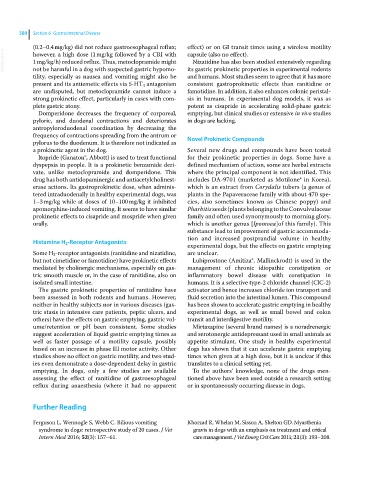Page 612 - Clinical Small Animal Internal Medicine
P. 612
580 Section 6 Gastrointestinal Disease
(0.2–0.4 mg/kg) did not reduce gastroesophageal reflux; effect) or on GI transit times using a wireless motility
VetBooks.ir however, a high dose (1 mg/kg followed by a CRI with capsule (also no effect).
Nizatidine has also been studied extensively regarding
1 mg/kg/h) reduced reflux. Thus, metoclopramide might
not be harmful in a dog with suspected gastric hypomo-
and humans. Most studies seem to agree that it has more
tility, especially as nausea and vomiting might also be its gastric prokinetic properties in experimental rodents
present and its antiemetic effects via 5‐HT 3 antagonism consistent gastroprokinetic effects than ranitidine or
are undisputed, but metoclopramide cannot induce a famotidine. In addition, it also enhances colonic peristal-
strong prokinetic effect, particularly in cases with com- sis in humans. In experimental dog models, it was as
plete gastric atony. potent as cisapride in accelerating solid‐phase gastric
Domperidone decreases the frequency of corporeal, emptying, but clinical studies or extensive in vivo studies
pyloric, and duodenal contractions and deteriorates in dogs are lacking.
antropyloroduodenal coordination by decreasing the
frequency of contractions spreading from the antrum or Novel Prokinetic Compounds
pylorus to the duodenum. It is therefore not indicated as
a prokinetic agent in the dog. Several new drugs and compounds have been tested
Itopride (Ganaton®, Abbott) is used to treat functional for their prokinetic properties in dogs. Some have a
dyspepsia in people. It is a prokinetic benzamide deri- defined mechanism of action, some are herbal extracts
vate, unlike metoclopramide and domperidone. This where the principal component is not identified. This
drug has both antidopaminergic and antiacetylcholinest- includes DA‐9701 (marketed as Motilone® in Korea),
erase actions. Its gastroprokinetic dose, when adminis- which is an extract from Corydalis tubers (a genus of
tered intraduodenally in healthy experimental dogs, was plants in the Papaveraceae family with about 470 spe-
1–3 mg/kg while at doses of 10–100 mg/kg it inhibited cies, also sometimes known as Chinese poppy) and
apomorphine‐induced vomiting. It seems to have similar Pharbitis seeds (plants belonging to the Convulvulaceae
prokinetic effects to cisapride and mospride when given family and often used synonymously to morning glory,
orally. which is another genus [Ipomoea]of this family). This
substance lead to improvement of gastric accommoda-
tion and increased postprandial volume in healthy
Histamine H 2 ‐Receptor Antagonists
experimental dogs, but the effects on gastric emptying
Some H 2 ‐receptor antagonists (ranitidine and nizatidine, are unclear.
but not cimetidine or famotidine) have prokinetic effects Lubiprostone (Amitiza®, Mallinckrodt) is used in the
mediated by cholinergic mechanisms, especially on gas- management of chronic idiopathic constipation or
tric smooth muscle or, in the case of ranitidine, also on inflammatory bowel disease with constipation in
isolated small intestine. humans. It is a selective type‐2 chloride channel (ClC‐2)
The gastric prokinetic properties of ranitidine have activator and hence increases chloride ion transport and
been assessed in both rodents and humans. However, fluid secretion into the intestinal lumen. This compound
neither in healthy subjects nor in various diseases (gas- has been shown to accelerate gastric emptying in healthy
tric stasis in intensive care patients, peptic ulcers, and experimental dogs, as well as small bowel and colon
others) have the effects on gastric emptying, gastric vol- transit and interdigestive motility.
ume/retention or pH been consistent. Some studies Mirtazapine (several brand names) is a noradrenergic
suggest acceleration of liquid gastric emptying times as and serotonergic antidepressant used in small animals as
well as faster passage of a motility capsule, possibly appetite stimulant. One study in healthy experimental
based on an increase in phase III motor activity. Other dogs has shown that it can accelerate gastric emptying
studies show no effect on gastric motility, and two stud- times when given at a high dose, but it is unclear if this
ies even demonstrate a dose‐dependent delay in gastric translates to a clinical setting yet.
emptying. In dogs, only a few studies are available To the authors’ knowledge, none of the drugs men-
assessing the effect of ranitidine of gastroesophageal tioned above have been used outside a research setting
reflux during anaesthesia (where it had no apparent or in spontaneously occurring disease in dogs.
Further Reading
Ferguson L, Wennogle S, Webb C. Bilious vomiting Khorzad R, Whelan M, Sisson A, Shelton GD. Myasthenia
syndrome in dogs: retrospective study of 20 cases. J Vet gravis in dogs with an emphasis on treatment and critical
Intern Med 2016; 52(3): 157–61. care management. J Vet Emerg Crit Care 2011; 21(3): 193–208.

